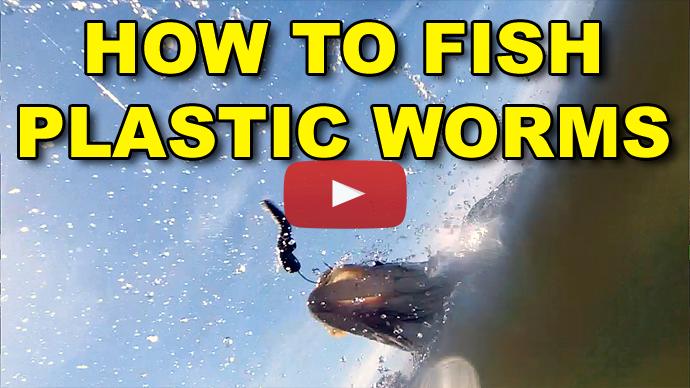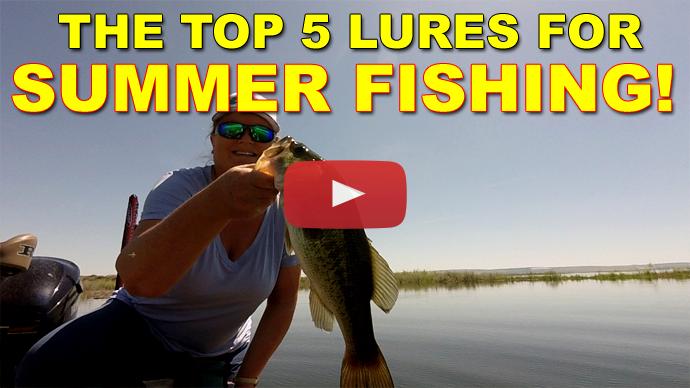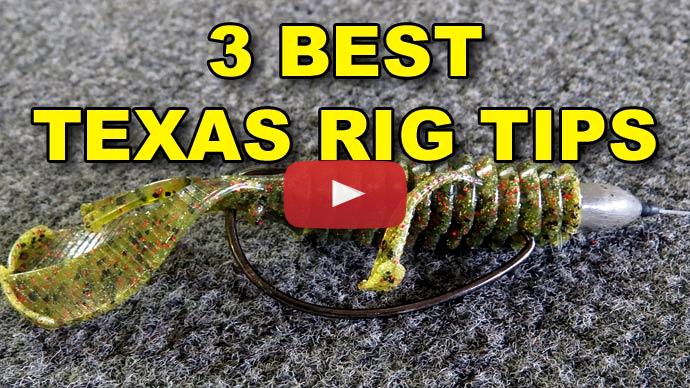Glenn: Hey, folks. Glenn May here with BassResource.com, and today, I wanna talk to you about one of my favorite baits, the Rage Bug. That's this guy right here. This is one of my most productive baits that I use year-round, and I'm gonna tell you why.
Actually, look at this. Look at the profile. It kinda mimics... It's kind of a blend between a baitfish and a crawfish, the two main things that bass eat all the time, so that's why it's so productive.
So, today I wanna talk to you a little bit about, first, what kind of rods and reels, line, the equipment and how to rig it, that sort of thing. And then I'm gonna go in and talk to about some of the different ways you can fish the Rage Bug. There's more than a couple of ways, you'll find out in just a second.
Keri: Whoa, you got one. A good one too. Nice, good one.
Glenn: There we go. Come here. Come on.
Keri: Nice.
Glenn: Right on the roof of the mouth. That right there. That will do. Look at that fatty. Nice. Let him go.
Now, my favorite way to fish the Rage Bug is flipping and pitching it in heavy cover, flooded bushes, timber, flooded trees, that sort of thing. So, I heavy up. I'm using a heavy power fast action rod, seven-foot long, paired with it is I got a Okuma Helios air reel. It's got a stout drag on it, which is what you're gonna need when you're flipping and pitching like this. The gear ratio on it isn't as important when you're flipping and pitching because you're not bringing it back really fast, but this has got like a 7:3:1 gear ratio on it.
I got a 50-pound Seaguar SmackDown braid, and the way I rig it, if you notice here, I've got a tungsten weight, a 3/8-ounce tungsten weight, but I've got a bobber stopper right here at the very top of it. And that prevents the weight from sliding up and down the line.
And I want that because when you're flipping in that heavy cover, you want the bait to bring, or the weight to bring the bait with it. You don't want the weight to drop down between everything and then your bait just sits there at the very top. That's not very effective. You got to get the bait down in there where the fish are hiding. So, that's why I put a bobber stopper on there. I don't use toothpicks or any kind of pegs because those can damage the line and you can end up breaking off at the hook set.
Now, because I'm using stout gear, I go all the way on through to the hook. This is a nice stout. It's called the flippin hook. That's what you want as a 4/0 flippin hook. Sometimes they're called super hooks, or super line hooks. But that's what you want. It's a thicker type of hook.
That way when you are setting the hook on a fish or fighting them in that heavy cover, it's gonna hold up to that. The regular size hooks what they'll do is they'll bend over time. You'll catch a few fish with them, but you'll notice they start to bend out more and more and more and pretty soon, they're getting hung up on everything, or if you really tie into a big fish, you can actually bend that hook out enough where the fish could break free. So, use a stout hook.
Now, if I'm not fishing that stuff. Say, for example, you're fishing just vegetation. Say, for example, hydrilla or milfoil, Lily pads, any kind of vegetation like that or you're maybe skipping under docks, that sort of thing where you don't have that heavy cover then you don't need a heavy set up like this. You can go with what I call all-purpose, the seven-foot, medium-heavy power, fast action rod. That works for all kinds of different types of lures, but it works well for this. Put on 15-pound Copolymer line works well. I like to use Seaguar's Tatsu or InvizX line if I'm fishing around docks, sometimes I'll use AbrazX if there's rocks around there because it holds up really well to fluorocarbon line, has more sensitivity, and use a regular hook, and you don't have to use a stout heavy hook on this. That will work perfect for those types of situations.
So, that's how I use it. Those are the different setups I use for rigging and using the Rage Bug. Now, let's go out and fish it.
There you go. Right when I make a cast too.
Keri: It's a good one.
Glenn: Good.
Keri: At least he thinks he is. He's not a...
Glenn: That's a decent one.
Keri: He's not a monster, but he's a...
Glenn: Now, I'll get it.
Keri: Whoa, Whoa, Whoa. He's a little mad. Hey, you don't like this. Come hither you.
Glenn: Good.
Keri: Little sucker-man, got a little weight to him.
Glenn: Yeah.
Keri: Little bug. Caught you. Thank you. Happy, happy, happy vacation. All right, little guy. Under the boat.
Glenn: Okay. So, one of the main ways that I fish this bait is pitching it. I love to pitch it in things like this. Look at all these flooded bushes in here. So, these are flooded Willow trees. Bass love this. Why? Because bluegill hang out in it. And like I mentioned before, this looks a lot like a bluegill profile that's why the bass will bite it.
So, all as I do is I just pitch it out there and let it sink to the bottom on slackline, watch it fall all the way down when it happens, because a lot of times it gets hit right when it's falling. And you won't know, you won't feel it because is falling a slackline. So, you have to watch your line. Your line will jump, twitch, pop. It might just start to swim off to one direction.
Well, as good of anglers as we are, I don't think we can make our lure do that over on this end of the, business end of the lure. So, guess what? The bass did that.
Reel up. What you wanna do when you get that strike is reel down first to the bait and then pop really hard. Give them a good snap set. It's a snap set hook. It's not a pull, not a tug, not really, really... It's boom. Give them a good pop to get that hook popped out of the bait and in the fish's mouth.
But it’s very simple. Just pitching it to different structure, it's all we're doing. And I just saw like about 30 bluegill go after this bait. They are in these bushes.
But yeah. This, I can do all day long and catch a ton of fish, just pitching it in all the bushes and flooded cover.
If you guys aren't very good at pitching, this is something you can practice in the wintertime. When it's raining outside, when it's stormy outside, when it's cold and icy, you can sit there and pitch all day long in your living room and practice. So, when you're out here on the water, you're not practicing how to do it, you're actually fishing.
Glenn: Here we go. Okay. This is a little bit stronger first than I anticipated. He's not that big, but...
Keri: Felt like a good one.
Glenn: Yeah. That'll work.
Keri: We caught a little fishy-poo.
Glenn: All righty.
Keri: Look at the little fishy. Oh, look at him go. Run away.
Glenn: Okay. So, the next technique I wanna show you is dragging it on the bottom. Now, it sounds simple, but there's actually a couple of tips about this that's gonna help you out.
First of all, just cast it out like you normally do. Let it fall slackline and wait for it to hit the bottom. And you'll know when it hits the bottom when the line just stops moving, and it's done that. Now that it's on the bottom, what you wanna do is put your rod tip down, reel down the slackline so you've got a tight connection between you and the bait.
Now, a lot of people will reel. Don't do that. Use your rod tip. By watching your rod tip, you can tell exactly how much you've moved that bait. So, I reel down and I just move a little bit with my rod tip. And I get about here, I stop, I don't keep going any further.
If I get a bite, I still wanna have some room to set the hook. So, if you bring it all the way over here and you get bit, you've got nothing left. Even so, even if I have it out here and I get bit, I wanna reel up as fast as I can and then set the hook. So, the further out over here you are, the less of a hook set that you've got. So, you don't want to bring it out too far.
But bring it back to the lure, and then you just slowly drag it. Let it pause a little bit, and reel. You can bring your reel, your rod right back down to it, and then again, pull it with the rod tip.
Now, you can experiment a lot with this. You can pull it slower, you can pull it faster, and you can make longer pauses in between the stops. Just keep experimenting with that and eventually, you'll figure out what the bass want.
Keri: Come on you. Come on kitty, kitty, kitty, kitty, kitty, kitty, kitty. Come on kitty, kitty, kitty, kitty, kitty, kitty. Here kitty, kitty, kitty. Here kitty, kitty, kitty, kitty. That time I got you.
That time we got you. Yep. Let's see. Easy, does it there big guy. Easy, doesn't big guy. Stop it. Oh, it fell out right when I picked it up.
Glenn: Nice.
Keri: Finally, look at what we got.
Glenn: Nice.
Keri: Hit the button. Look at what we got.
Glenn: Hey.
Keri: There you go. All righty fishy. He didn't wanna to come play. There he goes.
Glenn: Okay. So, the next technique I wanna show you is the lift and drop technique. This can be really productive, particularly in the spring and the summer months when they're around cover like you see here.
All is you do is you throw it out there, let it hit the bottom again like we've been doing. Like, I've just shown you, let it hit the bottom. When it gets all the way down, what you wanna do is lift that lure, first of all, point the rod down, reel up the slack, lift that lure off the bottom and then hold it while it falls back down and it hits the bottom again.
Now, this is a shallow lake that I'm in right now so that works. Now, if you're in really deep water, you might wanna follow it with your rod tip so it looks something like this. You would lift it up and then follow it back down till it hits the bottom.
Reel up that slack and feel for any fish. If you feel for a bite, you feel a little tick, subtle movement, set that hook. Watch that line all the time. If it bounces, jumps, moves to one side, then you got a fish. So, it's real simple. Just lift it up, let it fall back down, reel up that slackline and then you're ready to go again.
Keri: There you go. Oh, Holy Toledo. That's a good one. Come on. Turn on.
Glenn: There we go.
Keri: Big old hole in his mouth.
Glenn: Boy, that hook just.
Keri: I thought he was bigger than that. Nice one though.
Glenn: Rage Bug.
Keri: Rage Bug.
Glenn: Nice. That'll work.
Keri: That'll work.
Glenn: Thank you, buddy.
Keri: He stole your bug too. He's gone.
Glenn: So, the next way I fish it is to swim it. Okay. And that is basically keeping it off the bottom of the lake in various ways. Let me show you.
One of them is just the basics form. You just cast it out here and before it gets to the bottom, you start reeling it. And here you've got your rod tip up, keeping it off the bottom while doing a nice slow, steady retrieve. Okay. Just moving it along just like you would a crankbait or maybe a spinnerbait, but a nice, slow movement.
You can change that up a little bit. You can speed it up or slow it down. Or what I like to do as I'm bringing it in, sometimes I'll just pause it and let it drop and then I'll pick it back up again and then I'll pause it and let it drop again.
A lot of times you'll get whacked when you make that pause because fish will smack that lure. They think it's dying or it's injured and they'll hit it.
Another way to do it as you're swimming it is I'll swim it along and then, again, like I said, drop it, let it hit, and then I'll drag it on the bottom a little bit, and then bring it back up again rapidly.
I don't know what it is with a bait popping up off the bottom like that quickly that elicits a strike, but sometimes that's what the bass want. I can't explain why, but usually, it's in the warmer months or in the fall when they wanna hit it like that. Not always, but try that technique and sometimes you'd be surprised how many fish you catch.
But simply, swimming it back, I use that in the warmer months. I don't do it in the winter months because the fish don't tend to follow and chase baits, but in the spring and summer and fall, just swimming it back like that works really well.
One other thing that I like to do when I do this is I'll just vary the depth that's up. I have the rod tip up and then I'll bring the rod tip down and I'll bring the rod tip up and I'll bring it back down. And what that does, it speeds the bait up and then slows it back down, it drops a little bit.
And if you notice, I have the rod tip to the side. That way you can feel the strike better. If you have the right tip pointed right at it, then it's just a connection between the reel and the bait. Let the rod do the work for you. Let the rod help you figure out where the bite is. So, keep that rod tip a little bit to the side and you're gonna feel those subtle strikes.
I hope those tips help. For more tips and tricks like this, visit BassResource.com.



